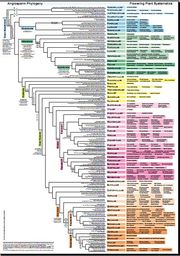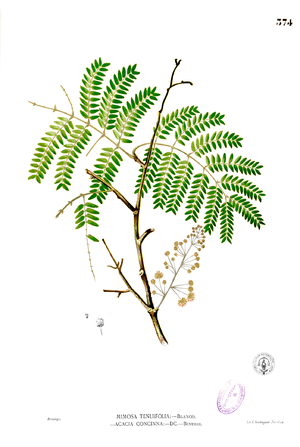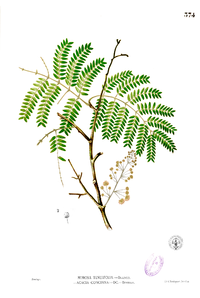Acacia concinna
Read community contributed articles on biodiversity & environment || Cultural practices & mythological stories related to Indian biodiversity || Official documents related to environment || NGOs, Blogs and Websites || Environment-related video collection || Plants of India || Mammals of India || Facebook || Twitter
Share this page: Acacia concinna
Acacia concinna or Shikakai is used in India in a variety of hair-care products. The bark of the plant contains a high level of Saponins which give the extract a foaming and cleansing characteristic. It belongs to the Acacia genus which has over 1100 members around the world.(AHS Encyclopedia)
Click here to see all Semantic Properties associated with this page
Please note that the above slideshow is automatically created by searching Flickr and does not contain manually curated images. Hence, it is likely that some images may not be exactly of Acacia concinna.
Click on the tabs below to know more...
- Species identity and nomenclature
- Current Wikipedia entry
- Binomial Classification
- Morphological features
- Habitat and Geographical Spread
- Medicinal Importance
- Cultural significance
- Commercial importance and cultivation
- Summary of PubMed articles
- Summary of NCBI molecular data
- External Links
- Images and Videos
| Parameter | Value(s) | References See complete references in the References section at the end |
|---|---|---|
| Names of users who have contributed to this species page | Gauravm | |
| Date on which this page was first created | 2010/06/15 | |
| This page was last modified on: | 24 November 2010 04:02:47 | |
| Name of the species | Acacia concinna | |
| ID on Encyclopedia of Life | 647774 | |
| Synonyms | Please check Binomial Classification section for synonyms. | |
| Common English Names | Soap pod | |
| Common Hindi Names | शिकाकाई Shikakai | |
| Common Indian names | Shikakai,शिकाकाई (Hindi);Shikakai,शिकाकाई (Marathi); Shika,Sheekay,Chikaikkai (Tamil); Cheeyakayi, Chinik-kaya, Shikai Cheenikka (Malayalam); Cheekaya, Chikaya, Gogu (Telugu); Sheegae, Shige kayi, Sigeballi (Kannada); Vimala (Oriya); Shikakai (Urdu); Amsikira, Kachuai, Pasoi tenga, Suse lewa (Assamese); Bahuphenarasa, Bhuriphena, Charmakansa, Charmakasa, Phenila (Sanskrit) | Flowers of India |
| Origins/Meanings of the common names | Shikakai means "food for the hair. It is called so because extract of the Shikakai fruit has been traditionally used as herbal shampoo. | Wikipedia, Gauravm |
Taxonomy from Encyclopedia of Life
If nothing is displayed in this section, it means the EoL ID has not been defined. Please click on Edit with form button on top and follow the instructions for filling in the EoL ID
{{#EoLOnlyHierarchy:647774}}
Taxonomy filled in form

Click here for the PDF of the phylogeny
| Taxon | Value |
|---|---|
| Regnum (Kingdom) | Plantae |
| Division | Magnoliophyta |
| Class | Magnoliopsida |
| Order | Fabales |
| Family | Fabaceae |
| Genus | Acacia |
| Source of data | ' |
| ||||||||||||||||||||
| Division | Taxon details | Taxon morphology details |
|---|---|---|
| Magnoliophyta | Also called Angiospermae. The ancestors of flowering plants diverged from gymnosperms around 245–202 million years ago, and the first flowering plants known to exist are from 140 million years ago. They diversified enormously during the Lower Cretaceous and became widespread around 100 million years ago, but replaced conifers as the dominant trees only around 60-100 million years ago. | These are seed plants like Gymnosperms, but can be differentiated by the presence of flowers, seeds containing endosperm and seeds that produce a fruit. Angiosperms are the most diverse and highly evolutionarily successful group of land plants. |
| ||||||||||||||||||||
| Class | Taxon details | Taxon morphology details |
|---|---|---|
| Magnoliopsida | Magnoliopsida is the scientific name for dicots. This class contains about ~1,99,350 species of Angiosperms. Eudicots are a subset of Dicots. Based on chloroplast DNA sequences, the divergence date between monocots and dicots is estimated to be ~200 million years, with a 40 million years uncertainty. | Dicots are diverse in habit, with half of all the species being more or less woody-stemmed - a reflection of the usual presence of a vascular cambium in the class. Annuals, biennials, vines, epiphytes, aquatics, parasites, and saprotrophs are also well represented in dicots. Vascular bundles of the stem are usually borne in a ring that encloses the pith. Vessel elements present except in some putatively primitive woody or aquatic families. Most dicots have a primary root system derived from the radicle, although some have an adventitious root system commonly seen in the class of monocots. Cotyledons are usually 2, seldom 1, 3, or 4. Leaves are mostly net-veined. |
| ||||||||||||||||||||
| ||||||||||||||||||||
| Family | Taxon details | Taxon morphology details |
|---|---|---|
| Fabaceae | Fabaceae is the third largest family of flowering plants, behind Orchidaceae and Asteraceae, with 730 genera and over 19,400 species. Found worldwide, this family contains many agronomically important plants such as Soybean, Phaseolus (beans), Green peas, Chickpeas, Alfalfa, Peanut,Carob), and Glycyrrhiza glabra (licorice). It has been suggested, based on fossil and phylogenetic evidence, that legumes originally evolved in arid and/or semi-arid regions along the Tethys seaway during the early Tertiary (Schrire2005). However, others contend that Africa (or even the Americas) cannot yet be ruled out as the origin of the family (Pan2010). | The leaves are stipulate, nearly always alternate, and range from pinnately or palmately compound to simple. Like the other legume families the petiole base is commonly enlarged into a pulvinus. The flowers are slightly to strongly perigynous, zygomorphic, and commonly in racemes, spikes, or heads. The perianth commonly consists of a calyx and corolla of 5 segments each. The petals are overlapping (imbricate) in bud with the posterior petal (called the banner or flag) outermost (i.e., exterior) in position. The petals are basically distinct except for variable connation of the two lowermost ones called the keel petals. The lateral petals are often called the wings. The androecium most commonly consists of 10 stamens in two groups (i.e., they are diadelphous with 9 stamens in one bundle and the 10th stamen more or less distinct). The pistil is simple, comprising a single style and stigma, and a superior ovary with one locule containing 2-many marginal ovules. The fruit is usually a legume. (Source:Hawaii Botany) |
| ||||||||||||||||||||
Based on classification
| Family | Taxon details | Taxon morphology details |
|---|---|---|
| Fabaceae | Fabaceae is the third largest family of flowering plants, behind Orchidaceae and Asteraceae, with 730 genera and over 19,400 species. Found worldwide, this family contains many agronomically important plants such as Soybean, Phaseolus (beans), Green peas, Chickpeas, Alfalfa, Peanut,Carob), and Glycyrrhiza glabra (licorice). It has been suggested, based on fossil and phylogenetic evidence, that legumes originally evolved in arid and/or semi-arid regions along the Tethys seaway during the early Tertiary (Schrire2005). However, others contend that Africa (or even the Americas) cannot yet be ruled out as the origin of the family (Pan2010). | The leaves are stipulate, nearly always alternate, and range from pinnately or palmately compound to simple. Like the other legume families the petiole base is commonly enlarged into a pulvinus. The flowers are slightly to strongly perigynous, zygomorphic, and commonly in racemes, spikes, or heads. The perianth commonly consists of a calyx and corolla of 5 segments each. The petals are overlapping (imbricate) in bud with the posterior petal (called the banner or flag) outermost (i.e., exterior) in position. The petals are basically distinct except for variable connation of the two lowermost ones called the keel petals. The lateral petals are often called the wings. The androecium most commonly consists of 10 stamens in two groups (i.e., they are diadelphous with 9 stamens in one bundle and the 10th stamen more or less distinct). The pistil is simple, comprising a single style and stigma, and a superior ovary with one locule containing 2-many marginal ovules. The fruit is usually a legume. (Source:Hawaii Botany) |
More details can be found in the Binomial Classification section.
Morphology from Encyclopedia of Life
If nothing is displayed in this section, it means the EoL ID has not been defined. Please click on Edit with form button on top and follow the instructions for filling in the EoL ID
{{#EoLOnlyDescription:647774}}
General morphology
| Parameter | Value(s) | References See complete references in the References section at the end |
|---|---|---|
| General morphological features of the plant | The plant is a climbing shrub having a thorny branch. Thorns are short and broad-based. | Flowers of India |
| Seed dispersal mechanism | ||
|---|---|---|
| Bloom type | FoI, Wiki | |
| Life cycle of the plant |
How to identify this species
For a detailed description, refer to the General Morphology details above
| Parameter | Value(s) | References See complete references in the References section at the end |
|---|---|---|
| Type of plant | Woody (Tree/Shrub) | |
| Plant height | 3 feet to 6 feet | Google Images |
| Flower color | Pink | FoI |
| Flower shape | ||
| Floral symmetry | ||
| Phyllotaxy of leaves | ||
| Leaf shape | ||
| Is the leaf petiolated or sessile? | ||
| Is the leaf simple or compound? |
| Parameter | Value(s) | References See complete references in the References section at the end |
|---|---|---|
| IUCN Conservation Status | Not Evaluated | EoL |
| Indian States in which the species has been documented | Assam,Andhra Pradesh,Arunachal Pradesh,Bihar,Delhi,Goa,Gujarat,Karnataka,Kerala,Madhya Pradesh,Maharashtra,Manipur,Meghalaya,Mizoram,Nagaland,Orissa,Pondicherry,Punjab,Rajasthan,Sikkim,Tamil Nadu,Tripura,Uttar Pradesh,West Bengal | ILDIS |
| Locations at which the species has been documented | ||
| Biotic zones inhabited | Northeastern Himalayas, Eastern Ghats, Western Ghats, Central Deccan Plateau, East Coast, West Coast, Indo-Gangetic Plain | Based on ILDIS |
| Details about the habitat | Rain forest, disturbed forest, open grassland, fields, creek sides, in open areas often a sprawling shrub; also recorded from limestone; altitude 50-1050 m | Neilson92 |
| Is this species native to India? | Yes | Wiki |
| Is the species indigenous/endemic to Sub-Himalayan regions? | No | Based on ILDIS |
| Is the species indigenous/endemic to Western Ghats? | No | Based on ILDIS |
| Is the species indigenous/endemic to Eastern Ghats? | No | Based on ILDIS |
More plants native to India
| ||||||||||||||||||||||||||||||||||||||||||
| Parameter | Value(s) | References See complete references in the References section at the end |
|---|---|---|
| Does this species have any medicinal use? | Yes |
|
Other plants of the same family having medicinal use:
| ||||||||||||||||||||||||||||||
| Parameter | Value(s) | References See complete references in the References section at the end |
|---|---|---|
| General types of ailments this species is used for treating | Infectious diseases, Organ-specific disorders | |
| Specific ailments for which the species is used | Skin diseases, Malaria, Dandruff control | FoI, Wiki |
| Medicinal systems which use this plant | Ayurveda, Folk Medicine | FoI, Wiki |
| Details of Medicinal use | The saponins produced from the fruit have a mildly low pH and detergent action, which gives them antibacterial cleansing properties. Decoction of the leaves acts as a purgative and is used to relieve malaria. An ointment prepared from ground pods is used as a skin cream. | FoI |
| Parts of the plant used for treatment | Leaves, Fruit | |
| Names of some medicinal active compounds in this plant, if known. | ||
| Details of the active chemical compounds found in this plant | ||
| Is the molecular basis of the medicinal action known? | ||
| Details of molecular basis of action | ||
| Are the toxic effects of consumption of this plant known? | ||
| Details of the toxic effects of the plant species | ||
| Have there been validation/clinical studies related to this plant? | ||
| Details of the clinical studies related to the plant species |
| Parameter | Value(s) | References See complete references in the References section at the end |
|---|---|---|
| Is this plant/plant-derived product used in food preparations? | No | User-reported |
| Part(s) of the plant used in the food preparations | ||
| Details of use in food preparations | ||
| Does this species have any religious significance? | No | User-reported |
| Religions which mention/give significance to this species | Google Images | |
| Religious occasions | ||
| Details of religious use |
| Parameter | Value(s) | References See complete references in the References section at the end |
|---|---|---|
| Is this plant cultivated commercially in India? | Yes | Gauravm |
| Uses for which the plant is commercially cultivated | Medicinal use, Cosmetic use, Other use | |
| Plant parts of commercial value | ||
| Products where this plant is used | User-reported | |
| Description of use | Used in shampoos and hair conditioners. The plant parts used for the dry powdered or the extract are the bark, leaves or pods. The bark contains high levels of saponins, which are foaming agents that are found in several other plant species. Saponin-containing plants have a long history of use as mild cleaning agents. Saponins from the plant's pods have been traditionally used as a detergent, and in Bengal for poisoning fish; they are documented to be potent marine toxins.
In commercial extracts, when the plant is hydrolyzed it yields lupeol, spinasterol, acacic acid, lactone, and the natural sugars glucose, arabinose and rhamnose. It also contains hexacosanol and spinasterone. The saponin of the bark has spermicidal activity against human semen. It appears to have a hormonal effect, leading to its use for contraceptive purposes. The leaves have an acidic taste and are used in chutneys. They contain oxalic, tartaric, citric, succinic and ascorbic acids, as well as two alkaloids, calyctomine and nicotine. An infusion of the leaves has been used in anti-dandruff preparations. Extracts of the ground pods have been used for various skin diseases. |
FoI, Gauravm,Wiki |
| States where this plant is cultivated commercially | ||
| Best period for planting this plant | ||
| Best period for harvesting this plant | All year round | |
| Method of propagation | Seeds, Vegetative propagation | AHS Encyclopedia |
| Water requirement of this plant | ||
| Pests and Diseases affecting this plant during cultivation | Spider mites, Mimosa webworms, scale insects, fungal leaf spots, Heart rot (caused by Armillaria), Root rot (caused by Ganoderma) | AHS Encyclopedia |
| Other considerations while cultivating this plant | Under glass, plants should be grown in potting mix in full light, plenty of water in growing season and sparing amounts in winter. Outdoors, the plants can be grown in moderately fertile, neutral to acidic soil in full sun. Hard pruning should be avoided.
Seeds can be sown in spring when the temperature is more than 18C after soaking in warm water until swollen. Semi ripe root cuttings can be planted in summer. |
AHS Encyclopedia |
Pubmed Word cloud
This word cloud is obtained using the tool LigerCat by searching the Pubmed database. LigerCat builds the cloud from the most relevant Medical Subject Headings (MeSH) terms. Each term's relative size indicates how many times it appears in the PubMed search results. Click on a term to access the full LigerCat cloud, with live PubMed search capabilities. LigerCat has been developed for the Biology of Aging Project.
The page may take some time to load since LigerCat is searching the entire PubMed database and sending us the results in real time.
- If there is an error message below, it means that there is no retrievable information available on NCBI
- If the number of nucleotide sequences is less than 100, very little genomic work has been done on this species. A respectable number of nucleotide sequences is above 10000.
- Most of the nucleotide sequences may come from three sources:
- Studies on single genes, where people try to sequence genes such as some specific dehydrogenases important,say, for tannin production
- Sequences of Ribosomal Internal Transcribed Spacer, whose sequence is used for generating molecular phylogenetic trees to establish species relationships
- Expressed Sequence Tags (ESTs) which can tell about which genes are present and expressed in the species at a particular time in the given tissue
{{#queryDB:taxonomy |Acacia concinna }}
| Parameter | Value(s) | References See complete references in the References section at the end |
|---|---|---|
| Details of modern scientific knowledge available for this species | Saponins extracted from A concinna have been reported to have spermicidal activities (Pakrashi et al, 1991), immunological adjuvant activities (Kukhetpitakwong et al, 2006) and anti-cancer, cytotoxic activities (Tezuka et al, 2000) | Inline references |
| Are herbarium specimen available for this species? | ||
| Institutes having herbarium samples |
If nothing is displayed in this section, it means the EoL ID has not been defined. Please click on Edit with form button on top and follow the instructions for filling in the EoL ID
{{#EoLOnlyAdditionalInfo:647774}}
References
Pakrashi (Journal) : Pakrashi et al (May 1991),Sperm immobilizing effect of triterpene saponins from Acacia auriculiformis, Contraception:43(5):475. doi=10.1016/0010-7824(91)90137-5
Kukhetpitakwong (Journal) : Kukhetpitakwong et al (2006),Immunological adjuvant activities of saponin extracts from the pods of Acacia concinna, International Immunopharmacology:6(11):1729. doi=10.1016/j.intimp.2006.08.004
Tezuka (Journal) : Tezuka et al (2000),Kinmoonosides A−C, Three New Cytotoxic Saponins from the Fruits of Acacia concinna, a Medicinal Plant Collected in Myanmar, J Nat Prod:63(12):1658. doi=10.1021/np000347f
AHS Encyclopedia (Book) : American Horticultural Society (2004),', ISBN: 9780756649159
FoI (Web): Flowers of India, Accessdate=2010-06-23
ILDIS (Web): International Legume Database, Accessdate=2010-06-23
| This article is a stub. You can help Project Brahma by expanding it. |

